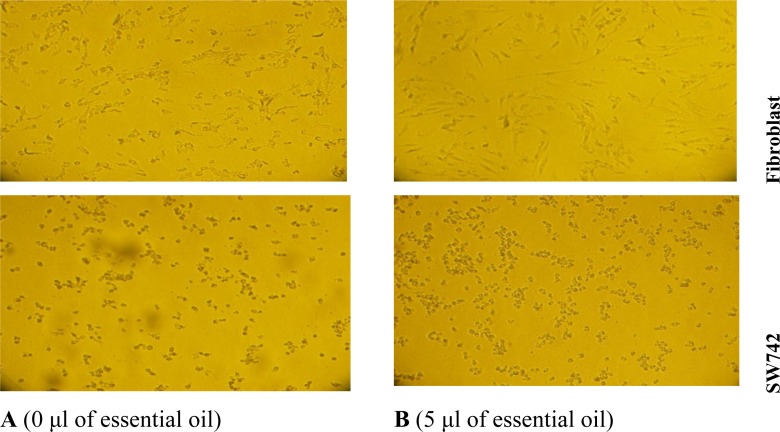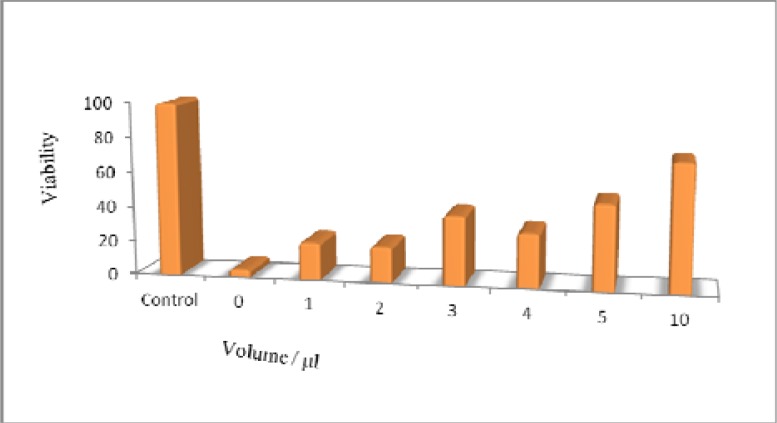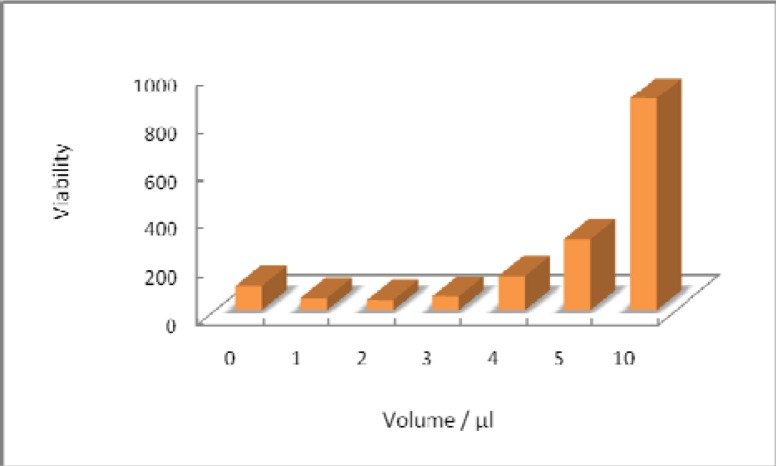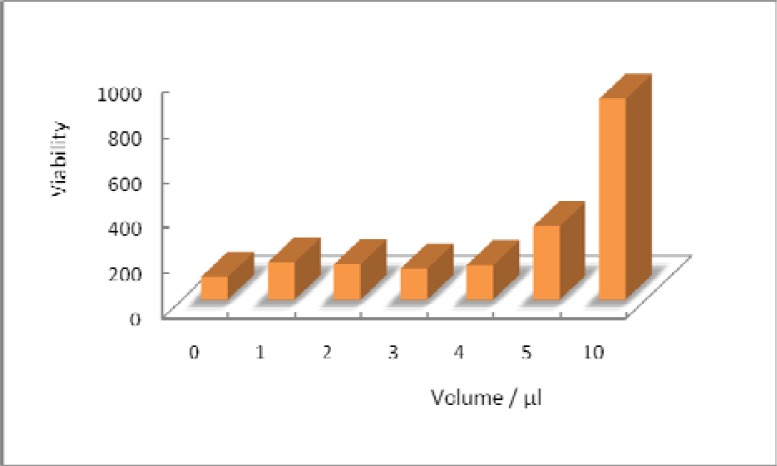Abstract
Aim
In this study, we report the effect of the essential oil of Rosa Damascena on human colon cancer cell line (SW742) and human fibroblast cells.
Background
Colon cancer is the second most common fatal malignancy. Owing to the existence of many side effects and problems related to common treatments such as surgery, chemotherapy and radiotherapy, alternative treatments are being investigated. Some herbal medicines have shown promising results against different types of cancers. Herbal medicines used have included the use naturally occurring essential oils.
Patients and methods
The essential oil of Rosa Damascena was obtained by distillation and its effect on SW742 cell-line and fibroblast cells were investigated with cell culture. The cells were cultured and different volumes of essential oil were induced to the cells. After48hincubation, cell survival was measured and using statistical analysis, the findings were evaluated and reported.
Results
This study showed that soluble part of Rosa Damascena oil increases cell proliferation in high volumes and the non-soluble component decreases cell proliferation.
Conclusion
The effects of essential oils, such as Rosa Damascena, on cell proliferation require more thorough investigation.
Keywords: Essential oil, Colon cancer cell line (SW742), Human fibroblast cell, Cell survival, Rosa Damascena
Introduction
Colorectal cancer is a leading cause of cancer related death in the US, and the second most prevalent fatal cancer worldwide. Half of all patients diagnosed with colorectal cancer eventually die from the disease. Less than 10% of patients with metastatic colorectal cancer will survive more than 5 years after diagnosis (1, 2). Digestive cancer patients generally undergo surgical therapy, chemotherapy, radiotherapy or a combination of these treatments. While the effects of these treatments are usually beneficial, most patients also suffer from significant side-effects (3). Historical documents confirm that Iran has a long-standing history, almost 3000 years, of medical research (4).This research has included the use of complementary medicines including herbal medicines, including aromatherapy. Treatments used in aromatherapy include essential oils obtainable from aromatic plants. Essential oils are volatile, complex compounds characterized by a strong odor and are formed by aromatic plants as secondary metabolites. Aromatherapy includes the inhaled, absorbed, or ingested use of essential oil extracts from plants and flowers for prophylactic medical care or active treatment. A growing body of clinical and laboratory studies report effects of essential oils on physiological and psychological processes in both animals and humans. Essential oils and their volatile constituents have been widely used for anti-microbial, insecticidal, anticancer, antioxidant, anti-diabetic, cardiovascular, and cosmetic and food applications (4–6).
Rosa Damascenais well known as medicinal herb. In addition to its perfume it has a long history of use in traditional medicine. Several pharmacological effects of this plant, such as a therapeutic effect on premenstrual breast tenderness and reduction of inflammation, especially of the neck, have been reported. The rose oil is famous, not only for its wide application in perfumery and cosmetics, but also, along with its aroma properties, it is a valued as a natural drug. It is believed to posses bacteriostatic properties and in addition have mood relaxing, anti-spasmodic and gall bladder healing effect. Avicenna et al reported a study of the rose oil and its has use in an aromatherapy treatment of cardiac diseases (7). In this study, biological activities of essential oil of this plant are evaluated against human colon cancer cell line.
Patients and Methods
The cell culture medium (RPMI), fetal bovine serum (FBS), phosphate buffered saline (PBS), Trypsin-EDTA Solution 1X, penicillin and streptomycin were provided by Gibco BRL (Life Technologies, Paisley, Scotland). 3-(4, 5-dimethyl-thiazol-2-yl)-2, 5-diphenyltetrazolium bromide (MTT) was provided from sigma Chemical Co. (St. Louis, MO) and DMSO was purchased from Merck (Germany).Cell culture plates and flasks were obtained from Nunc Co. (Roskilde, Denmark)
Essential oil distillation
A natural drying method was applied for drying the plant; it was dried at room temperature for two days. Usually the essential oils are extracted by distillation from aromatic herbs. Distillation is one of the most common methods for purification. Distillation means to separate the material into one, two or more different materials. These compounds have different evaporation time. The essential oil was extracted by a different apparatus - a steam distillation method (designed by Jaimand- Rezaee) (8).
Cell lines and cell culture
The human colon carcinoma cell lines (SW742) and human fibroblast cell lines studied in this research were obtained from National Cell Bank of Iran (NCBI) (Pasteur Institute, Tehran, Iran).
Cells were cultured in the RPMI-1640 medium supplemented with FBS (10%, v/v), streptomycin (100 µg/ml), and penicillin (100 U/ml).Cultures were maintained at 37°C in 5% CO2 and 95% air. Cultures were examined regularly. Approximately 104 cells were seeded into 96-well cell culture plates containing 200 µl medium and incubated at 37 °C under 5% CO2 for 24 h for MTT assay and microscopy purposes. Then, the various values of essential oils (0, 1, 2, 3, 4, 5 and10 0µl) were induced in triplicate to cells for 48h. Cell survival was assessed by Colorimetric MTT assay.
Cytotoxicity analysis by MTT assay
Measuring viability and growth of cells is done with different methods. An accurate method to evaluate the survival of cells normally is the yellow tetrazolium salt assay (MTT assay).This assay is based on the cleavage of the yellow tetrazolium salt, MTT, to form a soluble blue formazan product by mitochondrial enzymes, and the amount of formazan produced is directly proportional to the number of living cells s(9). In brief, this color can be measured by spectroscopic methods. There is a linear relation between the number of viable cells and absorption for each cell. This relationship allows providing accurate determination of any changes in the rate of cell proliferation (10–12). In this study, after SW742 and fibroblast cells were incubated for 48 hour with different values of essential oil, 20 µl MTT solution 0.5 mg/ml was added into the wells and incubation continued at 37°C for 3 to 5 hours. After this time the supernatant cells were removed, and instead of that 200 µl of DMSO solution was added for 15 min at room temperature. Finally, the percentage of cell viability was determined by ELISA reader in 570 nm. The percentage of cell viability was calculated using the equation: [mean optical density (OD) of treated cells/mean OD of control cells] × 100. Percent of cytotoxicity = 100 – percent of Viability (13, 14).
Morphological study
In order to compare the cell morphology and pattern of cell distribution in the absence (without essential oil) and presence of the essential oil an inverted microscope (Celti) was applied.
Results
The cells were examined with a microscope after incubation with the 0 and 5µl of essential oil. Their morphological changes were observed and photos are displayed in Figure 1.
Figure 1.
Fibroblast and SW742 cells morphology in the presence of A) 0µl and B) 5µl of essential oil.
As it is depicted in Figure 1 in the both cases (A and B) the fibroblast and SW742 cells morphology has been changed and differed from correspond cells that are cultured in another plate in the absence of essential oil as a control (see Figure 2).
Figure 2.

Fibroblast (left) and SW742 (right) cells morphology in the absenceof essential oil (the cells are cultured in the separated plate).
As it can be seen from Figure 2, normal fibroblast cells (in consist with literature (15) have an elongated and almost spindle-shaped figure in the absence of essential oil cultured in the plate (as an outer control), and also SW742 cells (as outer control) have a rounded appearance. The cells morphology and distribution influenced by essential oil even in the presence of 0µl of essential oil as an inner control.
From Figures 3 and 4 it can be inferred that survival percentage of cancer and normal cells in presence of various volumes of essential oil (control, 0, 1, 2, 3, 4, 5 and 10 µl) after 48h incubation using MTT method has been presented. For better understanding the data that are presented in Figures 3 and 4 are plotted again without outer control in Figures 5 and 6.
Figure 3.
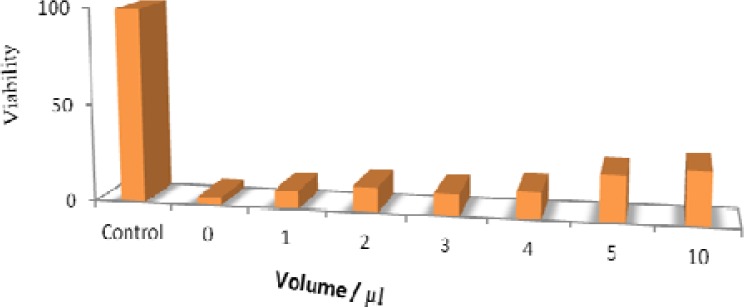
SW742 cell survival in the presence of different volumes of herbalessential oil after 48h incubation time using MTT assay.Cells populations that are cultured in another plate in the absence of essential oil are used as outer control.All amounts are different from control (P value ≤ 0.001).
Figure 4.
Fibroblast cells survival in the presence of different volumes of herbal essential oil after 48h incubation time using MTT assay. Population of the cells that are cultured in anotherplate in the absence of essential oil is used as outer control. All amounts are different from control (P value ≤ 0.001, except for 10μl ≤ 0.01).
Figure 5.
SW742 cell survival in the presence of different volumes of herbal essential oil after 48h incubation time using MTT assay. Inner control is thecells that are not treated with essential oil but are cultured in the same plate. The values of the (0μl), (1, 2 and 3μl), (4μl), (5μl) and (10μl) sets are statistically different.
Figure 6.
Fibroblast cell survival in the presence of different volumes of herbal essential oil after 48h incubation time using MTT assay.Inner control is thecells that are not treated with essential oil but are cultured in the same dish. The values of the (0μl), (1, 2, 3 and 4μl), (5μl) and (10μl) sets are statistically different.
Discussion
Colon cancer is one of the most common malignancies (16). Herbal plants are potentially useful candidates for treating cancer; they can synthesize a wide diversity of chemical compounds that may influence biological functions (16–19).Furthermore, the historically asserted chemo-preventive properties of aromatic plants are partially attributed to their volatile extracts (essential oils). These oils contain a wide variety of active phytochemicals, such as flavonoids, monoterpenes, and polyphenols, among many others (20). In this study the effect of essential oil of Rosa Damascena was investigated with a colon cancer cell line and normal human fibroblast cells. Following cell culture with the essential oils the cells were examined by MTT assay and results checked for consistence with a microscopic study. As is shown in Figure 1, microscopic studies indicate that, the morphology of SW742 cells and human fibroblast cells in the presence of various volumes of Rosa Damascena essential oil have been changed. As shown in Figure 2, these cells have been shown a high alteration in both cell morphology and survival.
In fact, the effect of essential oil on the both cell lines can be divided in two parts, the water-soluble and evaporated phases. Since the evaporated phase affects all the cultured cells in a similar way, future survival studies should consider both phases. Cell survival in the absence of essential oil (0µl volume of essential oil or inner control) is affected merely by evaporated phase; cell proliferation is noticeably inhibited (see Figures 3 and 4). It can be concluded that, evaporated phase of the oil has an absolute anti cell proliferation properties. It can be seen in Figures 3 and 4, that the trend in cell survival was consistent with the volume increment of essential oil.
For a better understanding of the water soluble phase of essential oil role, a control population was considered as assay indicator, and the evaporated phase effects were neglected (see Figures 5 and 6).
Figures 5 and 6 illustrate that cell growth is the dominant feature of the essential oil a sits volume is increased; the amount of water soluble phase is accompanied with the volume increment of essential oil. In addition to this, in the presence of 10µl of the essential oil, the viability increases about nine folds more than the inner control. In this study we outline two specific contradictory features of this essential oil: increased and decrease cell proliferation. As it is shown in Figure 5 and 6, cell growth inducing properties of water soluble in the case of 10 µl of essential oil is similar for both cell lines, but in lower volumes such as 2 or 3 µl, this process shows different effects in both cell line. In the presence of low volumes of essential oil the cell growth inducing properties of water soluble phase has a potent effect on fibroblast cell; however, it does not have considerable inducing effect on SW742 cell line.
As it is reported in previous studies (21), in tissue engineering it is essential to apply suitable growth factors for inducing normal cell proliferation but not for malignant cells; low dosages of water soluble phase of essential oil posses this aspect, so it can be consider as potential growth factor.
In conclusion, essential oil can be investigated in two different phases: a) Gaseous or vapor phase and b) water-soluble phase. The gas phase that could influence the internal control is an important factor inhibiting cell growth in both SW742 and normal fibroblast cells. In general, we can conclude that essential oil affected on cell survival by in two ways. Firstly, the water soluble phase of essential oil stimulates cell growth in high volumes and secondly the evaporated phase reduces the cell growth. As long as Rosa Damascena essential oil has less cytotoxic effects in low volumes on human fibroblast cells compared with cancer cells, this plant oil may be an eligible candidate for use as a growth factor. Further studies, as a result work, should be done for evaluation of cell death mechanisms of this plant, and also it is crucial to examine other cancer cell lines; similarly, in vivo studies are prominent to decipher the exact consequence of this plant.
Acknowledgments
This study is derived from MSc thesis of Miss Setareh Fayazfar. The financial support from Proteomics Research Center of Shahid Beheshti University of Medical Science is gratefully acknowledged.
(Please cite as: Rezaie-Tavirani M, Fayazfar S, Heydari-Keshel S, Rezaee MB, Zamanian- Azodi M, Rezaei-Tavirani M, et al. Effect of essential oil of Rosa Damascena on human colon cancer cell line SW742. Gastroenterol Hepatol Bed Bench 2013;6(1):25-31).
References
- 1.Goldberg RM, Sargent DJ, Morton RF, Fuchs CS, Ramanathan RK, Williamson SK, et al. A randomized controlled trial of fluorouracil plus leucovorin, irinotecan, and oxaliplatin combinations in patients with previously untreated metastatic colorectal cancer. J Clin Oncol. 2004;22:23–30. doi: 10.1200/JCO.2004.09.046. [DOI] [PubMed] [Google Scholar]
- 2.Jemal A, Siegel R, Ward E, Hao Y, Xu J, Murray T, et al. Cancer statistics, 2008. CA Cancer J Clin. 2008;58:71–96. doi: 10.3322/CA.2007.0010. [DOI] [PubMed] [Google Scholar]
- 3.Matsuda T, Maekawa K, Asano K, Hisamitsu T. Suppressive Effect of Juzen-Taiho-To on Lung Metastasis of B16 Melanoma Cells in vivo. Evid Based Complement Alternat Med. 2011;2011:743153. doi: 10.1093/ecam/nen081. [DOI] [PMC free article] [PubMed] [Google Scholar]
- 4.Azizi MH. History of Ancient Medicine in Iran. Arch Iranian Med. 2008;11:116–119. [PubMed] [Google Scholar]
- 5.Yang Y, Yue Y, Runwei Y, Guolin Z. Cytotoxic, apoptotic and antioxidant activity of the essential oil of Amomum tsao-ko. Bioresour Technol. 2010;101:4205–4211. doi: 10.1016/j.biortech.2009.12.131. [DOI] [PubMed] [Google Scholar]
- 6.Gedney JJ, Glover TL, Fillingim RB. Sensory and Affective Pain Discrimination after Inhalation of Essential Oils. Psychosom Med. 2004;66:599–606. doi: 10.1097/01.psy.0000132875.01986.47. [DOI] [PubMed] [Google Scholar]
- 7.Loghmani-Khouzani H, Sabzi Fini O, Safari J. Essential oil composition of rosa damascena mill cultivated in central Iran. Scientia Iranica. 2007;14:316–19. [Google Scholar]
- 8.Rezaei MB, Jaymand K, editors. Essential oils, distillations apparatuses, test methods of essential oils and retention indices in essential oil analysis; Tehran, Iran: Iranian Society of Medicinal Plants; 2006. [In Persian] [Google Scholar]
- 9.Sylvester PW. Optimization of the tetrazolium dye (MTT) colorimetric assay for cellular growth and viability. Methods Mol Biol. 2011;716:157–68. doi: 10.1007/978-1-61779-012-6_9. [DOI] [PubMed] [Google Scholar]
- 10.Maioli E, Torricelli C, Fortino V, Carlucci F, Tommassini V, Pacini A. Critical appraisal of the MTT assay in the presence of rottlerin and uncouplers. Biol Proced Online. 2009;3(11):227–40. doi: 10.1007/s12575-009-9020-1. [DOI] [PMC free article] [PubMed] [Google Scholar]
- 11.Ghavami S, Kerkhoff C, Los M, Hashemi M, Sorg C, Karami-Tehrani F. Mechanism of apoptosis induced by S100A8/A9 in colon cancer cell lines: the role of ROS and the effect of metalions. J Leukoc Biol. 2004;76:169–75. doi: 10.1189/jlb.0903435. [DOI] [PubMed] [Google Scholar]
- 12.Ebrahimi M, Rezaei Tavirani M, Heidari Keshel S, Raeisossadati R, Hoseinzade Salavati B, Daneshimehr F. Appraisal of fibroblast viability in different concentration of glucose as mimicry diabetic condition. Journal of Paramedical Sciences (JPS) 2011;2:36–41. [Google Scholar]
- 13.Zamanian- Azodi M, Rezaie-Tavirani M, Heydari-Kashal S, Kalantari S, Dalilan S, Zali H. Proteomics analysis of MKN45 cell line before and after treatment with Lavender aqueous extract. Gastroenterol Hepatol Bed Bench. 2012;5:35–42. [PMC free article] [PubMed] [Google Scholar]
- 14.Ardeshirylajimi A, Rezaie-Tavirani M, Mortazavi SA, Barzegar M, Moghadamniaand SH, Rezaee MB. Study of anti cancer property of Scrophularia striata extract on the human astrocytoma cell line (1321) Iranian Journal of Pharmaceutical Research. 2010;9:403–410. [PMC free article] [PubMed] [Google Scholar]
- 15.Seyyedi SS, Dadras MS, Tavirani MR, Mozdarani H, Toossi P, Zali AR. Proteomic analysis in human fibroblasts by continuous exposure to extremely low-frequency electromagnetic fields. Pak J Biol Sci. 2007;10(22):4108–12. doi: 10.3923/pjbs.2007.4108.4112. [DOI] [PubMed] [Google Scholar]
- 16.Ma Y, Peng J, Liu W, Zhang P, Huang L, Gao B, et al. Proteomics identification of desmin as a potential oncofetal diagnostic and prognostic biomarker in colorectal cancer. Mol Cell Proteomics. 2009:1878–1890. doi: 10.1074/mcp.M800541-MCP200. [DOI] [PMC free article] [PubMed] [Google Scholar]
- 17.Craig WJ. Health-promoting properties of common herbs. Am J Clin Nutr. 1999;70:491–99. doi: 10.1093/ajcn/70.3.491s. [DOI] [PubMed] [Google Scholar]
- 18.Soheili Kashani M, Rezaei Tavirani M, Talaei A, Salami M. Aqueous extract of lavender (Lavandulaangustifolia) improves the spatial performance of a rat model of Alzheimer's disease. Neurosci Bull. 2011;27:99–106. doi: 10.1007/s12264-011-1149-7. [DOI] [PMC free article] [PubMed] [Google Scholar]
- 19.Zali H, Rezaei-Tavirani M, Azodi M. Gastric cancer: prevention, risk factors and treatment. Gastroenterol Hepatol Bed Bench. 2011;4:175–85. [PMC free article] [PubMed] [Google Scholar]
- 20.Lai PK, Roy J. Antimicrobial and chemopreventive properties of herbs and spices. Curr Med Chem. 2004;11:1451–60. doi: 10.2174/0929867043365107. [DOI] [PubMed] [Google Scholar]
- 21.Brochhausen C, Lehmann M, Zehbe R, Watzer B, Grad S, Meurer A, et al. Tissue engineering of cartilage and bone: growth factors and signaling molecules. Orthopade. 2009;38:1053–62. doi: 10.1007/s00132-009-1496-5. [DOI] [PubMed] [Google Scholar]



